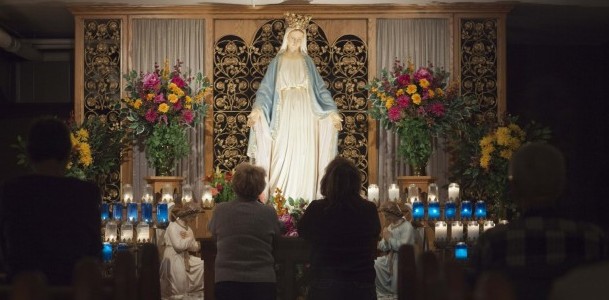This post was submitted by Warren Schmidt, CSB.
As October draws to a close, I offer a few reflections on the association of the month of
October with Mary.
The historical roots of October as a month of Mary are unclear. Some attribute the
association between October and Mary to the devotion to Our Lady of Fatima. On October 13,
1917, in Cova de Iria outside of Fatima, Portugal, the last of six monthly Marian apparitions to
three shepherd children is said to have taken place. On this day, a crowd of approximately
70,000 pilgrims reported witnessing what became known as “the miracle of the sun,” in which
the sun appeared to “dance” about in the sky and could be looked upon directly without burning one’s eyes.
Others associate October with Our Lady of the Rosary, while May, the month of the first
Fatima apparition, is more traditionally the month to celebrate the devotion to Our Lady of
Fatima. In fact, October 7 is the feast day of Our Lady of the Rosary. It began as the feast of Our
Lady of Victory, instituted in 1571 after a Christian military victory in the Battle of Lepanto. In
1573, this feast day was renamed Our Lady of the Rosary by Pope Gregory XIII, and in 1716,
Our Lady of the Rosary was celebrated as a feast of the universal Church for the first time.
Devotion to the Rosary was nothing new by 1716. It may have had early medieval
monastic origins. Instead of praying the full 150 Psalms of the Bible in a cycle as monks did at
the time (and many still do), laypeople, many of whom were illiterate, were encouraged to
substitute 150 beads, arranged in a circle, on which they would repeat basic prayers by rote: the Our Father, the Hail Mary, and the Glory Be. While they recited these prayers, the people
meditated on the events (mysteries) of the life of Jesus. Therefore, the Rosary became a valuable instrument of prayer and meditation, as well as a powerful means of teaching of the truths of the Christian faith.
Fr. Jim Phalen, CSC, President of Family Rosary International, puts forward another
possible connection between the Rosary, Mary, and the months of May and of October. Fr.
Phalen observes that, in the northern hemisphere, May is a month of new life; of spring. October, conversely, is when the green leaves of spring and summer slowly die, but “in their dying they become more beautifully colorful than ever.” Of course, the opposite is true in the southern hemisphere, where in October the earth brings forth new life. Nevertheless, these two months are excellent times to remember the life of Jesus through the Rosary, and the role of his mother, Mary as first disciple in this plan of God, from Jesus’ conception via the Holy Spirit in her womb, to the agony and yet triumph of the cross, to the glory of Christ’s resurrection and ascension, and to the birth of the Church at Pentecost.
All these thoughts as to the origins of October as a Marian month make ascertaining the
beginnings of such a designation essentially impossible. There are many reasons for celebrating Mary, in October or at anytime. She is also rightly celebrated under many titles. The First Council of Ephesus in 431 first defined Mary dogmatically as Theotokos, or God-bearer, in Greek. More recently, Vatican II’s Dogmatic Constitution on the Church, Lumen Gentium (1964), devoted its entire final chapter to a reflection on Mary. These among other documents, as I see them, affirm at the highest level of Church teaching Mary’s importance for our faith. Mary is not so much exalted in her own right, but because she points us in two directions: Through her are revealed truths first about her Son, Jesus, fully both human and divine and, second, about us.
In October, in a special way, we remember Mary both as Mother of God and as our
mother. This month includes the feasts of Our Lady of the Rosary (October 7), as well as those
of Blessed John Paul II (October 22), and of a Canadian, Blessed Marie-Rose Durocher (October 6), both great devotees of Mary. October also begins with the memorial of St. Thérèse of the Child Jesus. The French Carmelite once wrote that she was drawn especially to Mary, not so much because she is Queen of heaven, but because she is our mother. Let us, with St. Thérèse among all God’s saints, this October and forever, rejoice that we are children of so great a mother.
---
Warren Schmidt is a Basilian Scholastic, studying at St. Michael's College at the University of Toronto.
(CNS photo/Darren Hauck, Reuters)
